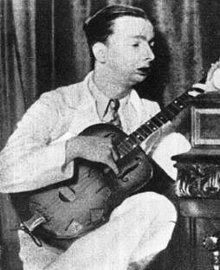- Noel Rosa
-
Noel Rosa 
Background information Birth name Noel de Medeiros Rosa Born December 11, 1910 Origin Rio de Janeiro, Brazil Died May 4, 1937 (aged 26) Genres Samba, marchinha Occupations Songwriter, singer Instruments Singer Years active 1929–1937 Noel de Medeiros Rosa (December 11, 1910 - May 4, 1937) was a Brazilian songwriter, singer, and guitar/banjo player. One of the greatest names in Brazilian popular music, Noel gave a new twist to samba, combining its Afro-Brazilian roots with a more urban, witty language and making it a vehicle for ironic social commentary.
Noel Rosa was born in Rio de Janeiro into a middle-class family of the Vila Isabel neighbourhood. An accident with a forceps at his birth caused the disfigured chin that would haunt him all his short life. He learned to play the bandolim while still a teenager, and soon moved on to the guitar. Although Noel started medicine studies, he gave most of his attention to music and would spend whole nights in bars drinking and playing with other samba musicians. Together with Braguinha and Almirante he formed the musical group "Bando de Tangarás". Soon he started composing sambas, and had his breakthrough with "Com que roupa?", one of the biggest hits of 1931 and the first in a string of memorable compositions. Noel was a good friend of Cartola, who have received and trated him after some drinking nights several times in his house on the Mangueira's slum.
In the early 1930s Noel Rosa started to show signs of a tuberculosis. He would occasionally leave for treatment on mountain resorts, but always ended up coming back to Rio and the nightlife. In 1934 he married Lindaura Martins, a seventeen-year old neighbour, but that didn't keep him from having affairs with other women. Noel was a heavy smoker, and most of his photographs show him with a cigarette hanging from his lower lip. By the later 1930s his health had seriously deteriorated, and he died in 1937 at the age of 26.
Compositions
Noel Rosa wrote around 250 compositions, including:
- "A.E.I.O.U." (with Lamartine Babo, 1931)
- "Até amanhã" (1932)
- "Cem mil réis" (with Vadico, 1936)
- "Com que roupa?" (1929)
- "Conversa de botequim" (with Vadico, 1935)
- "Coração" (1932)
- "Cor de cinza" (1933)
- "Dama do cabaré" (1934)
- "De babado" (with João Mina, 1936)
- "É bom parar" (with Rubens Soares, 1936)
- "Feitiço da Vila" (with Vadico, 1936)
- "Feitio de oração" (with Vadico, 1933)
- "Filosofia" (with André Filho, 1933)
- "Fita amarela" (1932)
- "Gago apaixonado" (1930)
- "João Ninguém" (1935)
- "Minha viola" (1929)
- "Mulher indigesta"
- "Não tem tradução" (1933)
- "O orvalho vem caindo" (with Kid Pepe, 1933)
- "O X do problema" (1936)
- "Palpite infeliz" (1935)
- "Para me livrar do mal" (with Ismael Silva, 1932)
- "Pastorinhas" (with João de Barro, 1934)
- "Pela décima vez" (1935)
- "Pierrô apaixonado" (with Heitor dos Prazeres, 1935)
- "Positivismo" (with Orestes Barbosa, 1933)
- "Pra que mentir" (with Vadico, 1937)
- "Provei" (with Vadico, 1936)
- "Quando o samba acabou (1933)
- "Quem dá mais?" (1930)
- "Quem ri melhor" (1936)
- "São coisas nossas" (1936)
- "Tarzan, o filho do alfaiate" (1936)
- "Três apitos" (1933)
- "Último desejo" (1937)
- "Você só...mente" (with Hélio Rosa, 1933)
- "Mama de farinha" (with Hélio Rosa, 1943)
Books
- No Tempo de Noel Rosa. (Almirante)
- Noel Rosa: Uma Biografia. (João Máximo e Carlos Didier)
- Noel Rosa: Língua e Estilo (Castellar de Carvalho e Antonio Martins de Araujo)
- Songbook Noel Rosa 1, 2 e 3 (Almir Chediak)
- Noel Rosa: Para Ler e Ouvir (Eduardo Alcantara de Vasconcellos
- O Jovem Noel Rosa (Guca Domenico)
- O Estudante do Coração (Luis Carlos de Morais Junior)
Categories:- 1910 births
- 1937 deaths
- Brazilian composers
- Brazilian singers
- Brazilian songwriters
- Samba musicians
- People from Rio de Janeiro (city)
Wikimedia Foundation. 2010.
